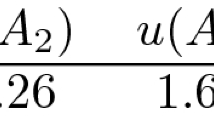Abstract
Call b your balance function at wealth W if you are indifferent between W and a 50–50 lottery with outcomes x and b(x). Given one b, u is arbitrary on one side of W but then determined on the other. Given two b‘s, u is arbitrary between the two W′ s but then determined elsewhere. Additional properties of u restrict the b’s but do not ordinarily make u unique. Contradictions can occur. Given three b′ s, an algorithm is developed using minimal domains of definition that determines the relative utility of the W’s. If it is irrational, then the set S generated by applying all combinations of b’s to W′ s is dense and u is determined. If finitely many b’s are rationally related, then S is discrete, a further algorithm determines it, the values of u on S are equally spaced, and u is arbitrary between any two adjacent points of S but then determined elsewhere. Infinitely many balance functions determine u unless they are rationally related in a uniform way.
Similar content being viewed by others
References
Gollier, Christian and John W. Pratt. (1996). “Risk Vulnerability and the Tempering Effect of Background Risk,” Econometrica 64, 1109–1123.
Meyer, Richard F. and John W. Pratt. (1968). “The Consistent Assessment and Fairing of Preference Functions,” IEEE Transactions on System Science and Cybernetics (SSC-43), 270–278.
Pratt, John W. (1961). “Remarks on the Relationship Between Utility and the Certainty Equivalent of a 50 School.
Pratt, John W. (1992). “Risk Aversion.” In John Eatwell, Murray Milgate, and Peter Newman (eds.), The New Palgrave Dictionary of Money and Finance London: MacMillan.
Raiffa, Howard. (1968). Decision Analysis, Addison-Wesley.
Samuelson, Paul A. (1992). “Risk Tolerances, Distributive Inequality, and Track Bettors′ Equilbrium.” In P. Dasgupta, D. Gale, O. Hart, and E. Maskin (eds.), Economic Analysis of Markets and Games: Essays in Honor of Frank Hahn. MIT Press.
Schlaifer, Robert. (1969). Analysis of Decisions Under Uncertainty, McGraw-Hill.
Author information
Authors and Affiliations
Corresponding author
Additional information
JEL Classification: D81
Rights and permissions
About this article
Cite this article
Pratt, J.W. How Many Balance Functions Does it Take to Determine a Utility Function?. J Risk Uncertainty 31, 109–127 (2005). https://doi.org/10.1007/s11166-005-3551-x
Issue Date:
DOI: https://doi.org/10.1007/s11166-005-3551-x




